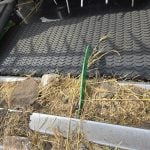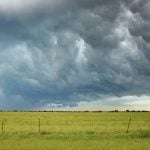Many producers are seeding farmland to perennial forages this spring. Bob Springer, rangeland agrologist with the Grazing and Pasture Technology Program in Swift Current, Sask., has a few tips to increase their success. “The first and one of the most important steps is to select the species and variety best suited for the intended use […] Read more
Stories by Saskatchewan Agriculture
Dig out gloves and boots for safe spraying season
As pesticide season approaches, producers should be giving some thought to their own safety, says Clark Brenzil, weed control specialist with Saskatchewan Agriculture. “Protection from pesticides is often one of the first things to slip when the busy season is on, so producers should take time now to prepare supplies of safety equipment,” he said. […] Read more
Harvest puts timber to use, allows regeneration
A new plan to harvest trees on a provincial pasture near Duck Lake, Sask., might prove to be a model for getting greater value out of the resource. A 20-year plan for sustainable harvest and reforestation for the Wingard Pasture is expected to begin at the end of the 2000 grazing season. “Depending on the […] Read more
Don’t plant fusarium-infected seed
The importance of using clean cereal and grass seed to prevent the spread of fusarium head blight cannot be over-emphasized, says Myriam Fernandez, a research scientist in plant pathology at the Semiarid Prairie Agricultural Research Centre in Swift Current, Sask. Using seed from areas where fusarium head blight is well established, even if it is […] Read more
Market welcomes Cool Canola
Heather Jonas of Saskatoon is a snacker. So when her doctor told her she had to go on a low-cholesterol diet, she began searching for low-cholesterol snack foods. This search eventually resulted in two new food products and the establishment of a Saskatchewan food processing company called Cool Sun Foods Inc. At an Edmonton trade […] Read more
Beef study helps cow-calf producers to identify costs
Cow-calf producers should know their costs of production before they alter their operations. Saskatchewan farmers who participated in the 1998 Beef Production Economics Project discovered that the average cost of production per pound of weaned calf that year was $1.04. This included feed and the other costs of raising replacement heifers. “If the cost of […] Read more
Too much selenium is toxic
Selenium deficiency in cattle can be a serious condition, but producers who try to fix the problem can cause bigger problems. Known as white muscle disease, selenium deficiency mainly attacks newborn calves. The condition affects all muscles of the animal, including the heart. Affected cattle cannot stand or walk, have difficulty swallowing or breathing and […] Read more
Sclerotinia: a crop rotation or a weather issue?
The incidence of sclerotinia in canola was higher than normal in 1999. Canola is usually the crop most severely affected by sclerotinia, but the incidence of this fungal disease was higher than usual in lentil and pea crops as well. Sclerotinia also affected yields in chickpeas, sunflowers and flax this year. Farmers planning next year’s […] Read more
Flies used for manure control
Livestock producers may have to look at flies in a whole new light. An entomologist from the University of Georgia is cultivating flies as part of a process that reduces manure and produces a high-protein feed. Craig Sheppard, who was in Sask-atchewan recently to explain his findings, has worked with the black soldier fly at […] Read more
New publications focus on pastures and forages
Two forage publications have been released by the Grazing and Pasture Technology Program in response to marginal cropland being identified as one of the program’s top priorities. “This included the economics of forages on marginal farmland and their agronomics,” said program manager Zoheir Abouguendia. “There is a need to know both.” Abouguendia said cropland could […] Read more



